There is, at the start of the trailer for the 1946 film version of The Big Sleep, a surreal vignette in which Humphrey Bogart, already in character as the trench-coated private eye, browses the Hollywood Public Library stacks and asks an attractive librarian to recommend “a good mystery, something off the beaten track like The Maltese Falcon.” The woman pulls a book from the shelf and drolly tells Bogart (or is it Sam Spade? Philip Marlowe?) that he should try Raymond Chandler’s latest bestseller, The Big Sleep, which Bogart then opens and begins reading aloud—“Sometimes I wonder what strange fate brought me out of the storm to that house that stood alone in the shadows”—a line which appears nowhere in The Big Sleep, the book or the movie. The layers of unreality are many and strange, and whenever I watch the clip, I catch myself thinking with a gin-soaked drawl, “You know what I could go for? A good mystery, something off the beaten track, like The Maltese Falcon…”
There’s a pleasant, circular thrill to reading mysteries in which books play a central role. In The Big Sleep, a bookstore owner named Arthur Geiger is the villain—a blackmailer and pornographer. But in the annals of crime fiction, the far more common, and to my mind equally compelling, scenario involves the book dealer as detective. It’s a sensible device: a romantic profession, something to take the edge off a brutish private eye, and a job that now and again requires trade in goods of dubious, or at the very least mysterious origins. Meanwhile the reader is given that special charge: holding a book in his or her hands while simultaneously being assured that books are precious things—totemic, even—and that those who appreciate them may someday be called to defend honor and right the world’s wrongs.
A fantasy, sure, but an intoxicating one, and available in abundance if you know where to look. From Havana to Madrid to New York City past and present, book dealer sleuths can be found the world over scouring shelves, chasing demons and foiling the occasional crime.

Leonardo Padura, The Mario Conde books
Mario Conde, a former police lieutenant turned private investigator, has always identified with novelists, derelicts, drunks and other literary types. In semi-retirement, he passes the time between cases scouting used books all around Havana. He’ll buy or sell, and while he may be a little seedy, he’s an honest shamus in the tradition of Marlowe, with his own code and a cynical worldview that almost always cracks under a little sentimental pressure. Conde appears in a slew of Padura’s books, most famously The Havana Quartet (Las cuatro estaciones) and most recently Heretics (Herejes). For gritty atmosphere and (high stakes) social critique, Padura’s work is among the best crime fiction around. And to sweeten the pot, Netflix recently adapted the Havana Quartet as a miniseries starring Jorge Perugorria.
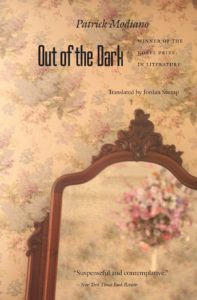
Patrick Modiano, Out of the Dark
Modiano’s stylish, searching novels are masterpieces of atmosphere. Most follow a common plot: a man looks back at a troubling incident, usually from his youth, and tries to decipher what, exactly, he was caught up in. In Out of the Dark, the narrator (unnamed) recalls his days living in student hotels on the Left Bank, surviving by selling review copies and nicked volumes to the bouquinistes. In his travels around the quarter, he meets a young couple—Van Bever, a gambler, and his girlfriend, Jacqueline, a pinball junkie with no winter coat and an ether habit. They’re planning to leave Paris for Majorca, where there’s an American, a crime fiction author, who will put them up. For reasons unknown, they invite the narrator to join them. Soon, he gets involved with Jacqueline. A crime is committed, or perhaps several crimes. They go on the run. They part. Thirty years later, he sees her on the street and is once again compelled to follow. It’s Vertigo in Paris, with books and shabby glamor.
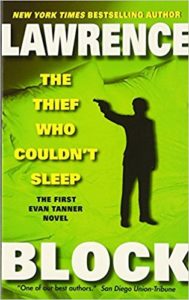
Lawrence Block, The Burglar series (The Thief Who…)
The proprietor of Barnegat Books in New York City’s Greenwich Village is also a locks savant with a penchant for entering homes when the owners are out of town. Bernie Rhodenbarr steals to keep his used book business afloat, although he’ll also take the occasional flyer to stave off boredom, or if his best friend Carolyn presents him with a can’t-miss opportunity. Rhodenbarr’s sufficiently well known to the police that he often finds himself having to track down the real criminals in order to clear his own name. His creator, Lawrence Block, knows the ins-and-outs of New York City as well as any author, so count on a healthy dose of urban color (e.g. a Holocaust survivor on the Upper West Side with an insatiable sweet tooth and a tidy business as an upscale fence). Block is a hardboiled master, and the Bernie Rhodenbarr series will give you plenty of grit, but you’ll also get some whimsy, not to mention a good number of obscure titles and edition points.

John Dunning, The Cliff Janeway series
John Dunning’s Bookman series is quintessential book dealer noir. In 1984, Dunning went on hiatus from his writing career and opened Old Algonquin Bookstore in Denver. Almost ten years later, he returned to writing with a new hero—Cliff Janeway, a retired detective now operating a well-regarded rare books business. The Janeway novels are most famous for their realistic depiction of the trade, right down to the going price for a first edition of Raymond Chandler’s The Lady in the Lake ($1,000 in 1992) and the value of early Saul Bellows as collector items. The professional curiosities change as the Internet age dawns, but you can always count on Dunning for a good caper laced with professional know-how.
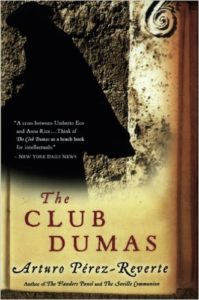
Arturo Pérez-Reverte, The Club Dumas
The Club Dumas is the source material for Roman Polanski’s 1999 film, The Ninth Gate. The novel dives even deeper into the world of eccentric, cutthroat bibliophiles. Lucas Corso, an antiquarian dealer skilled at tracking down and authenticating (without regard for law or ethics) the world’s most elusive volumes, is tasked with two projects: one a newly- discovered draft of The Three Musketeers; the other an obscure illuminated text with extreme occult implications. Corso goes sleuthing around Europe at the behest of his wealthy clients, interrogating one literary oddball after another, gradually unlocking a dark secret and bringing a femme fatale into the light. One of the book’s great delights is Pérez-Reverte’s Borgesian knack for creating and describing fake scholarship and invented texts to rival the real, all of it mixed up in a great swirl of names, titles and European locales.
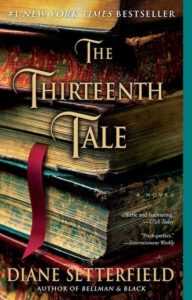
Diane Setterfield, The Thirteenth Tale
Setterfield’s 2006 debut, released to wide acclaim and hefty sales, is an odd fit for this list. At its heart is a gothic novel—a dilapidated estate, creepy twins, family secrets—but the frame is closer to a traditional mystery, if not a crime story. Margaret Lea, the daughter of an antiquarian dealer, is summoned by a famous writer, Vida Winter—”this century’s Dickens.” Over several meetings, Winter tells Setterfield the story of “Angelfield House.” It’s up to Lea to decipher what the story means—who are these characters, why is she being told about them, and how do her own secrets factor in? Gothic and Noir are kissing cousins, in style and in outlook: the world is a web of questions and secrets, and at the center of every story is a poor soul who finds him or herself compelled toward the bitterest of ends.
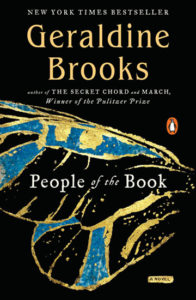
Geraldine Brooks, People of the Book
This 2008 novel is another outlier, more biblio-historical than traditional mystery, but by far the book’s liveliest sections belong to Hannah Heath, a rare books expert (not strictly a dealer) called to Sarajevo to analyze the city’s famed Haggadah, one of the world’s most ancient and beautiful holy books. The illuminated text, which was created by Spanish Jews and later secreted to Bosnia, escaped the Inquisition, Nazis and the attacks of Sarajevo. At times, it was kept safe by Muslim librarians and clerics. Heath’s job is to oversee its conservation. That requires deciphering various symbols, stories and artifacts, as well as enduring grave personal danger—never a dull, or a safe moment. Brooks is a supremely talented storyteller, and People of the Book unlocks one mysterious world after another.
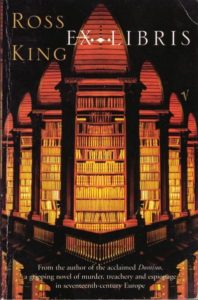
Ross King, Ex Libris
King is now best known as the author of popular histories covering Europe’s great artistic achievements—Il Duomo, the Sistine Chapel. But earlier in his career he wrote some pretty entertaining historical novels. Ex Libris tells the story of Isaac Inchbold, a 17th-century London book dealer given the job of reconstructing a noble family’s library, recently plundered by Cromwell’s forces. Pursued by black-clad goons, Inchbold travels across the continent in search of obscure treasures, desperately trying to outfox the many scoundrels and sharps populating Europe’s rare books market. There’s a twist and an esoteric revelation at nearly every corner—even the most ardent reader will weary of them at some point. But King’s writing is crisp and his world is alive with energy and scholarship.

Thomas McDade, Thieves of Book Row
McDade’s Thieves of Book Row is a touch of true crime. It’s Depression-era New York City. Book Row is in full swing. The labor force is starting to buckle. And meanwhile, a recently held auction has set record prices for certain treasures of the rare book world, many of which, as it happens, can still be found in the New York Public Library’s un-guarded collection. McDade lays out a Gangs of New York-style cosmology of the Book Row dealers who turned to a life of crime—Sam Dupree, the Swede, and Babyface Mahoney. Chasing after them is G. William Bergquist, the chief investigator of the NYPL. McDade is the country’s foremost expert in book crime and a good yarn spinner, capable of explaining the cultural significance of a rare Melville or Poe volume, as well as the intricacies of a thoughtful heist.
Bonus: For more bookish crime fiction, check out the Bibliomystery Series, a monthly chapbook from the Mysterious Bookshop in New York City. Every story features books and literary trappings, plus a dose of mystery. Megan Abbott, Laura Lippman, Joyce Carol Oates and other luminaries have contributed to the series.

















